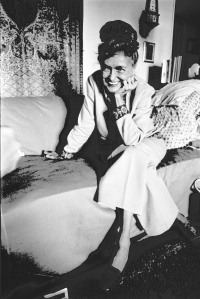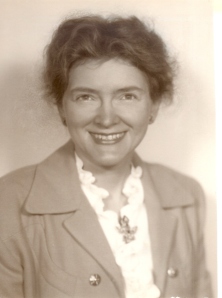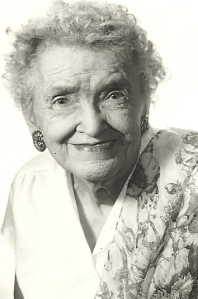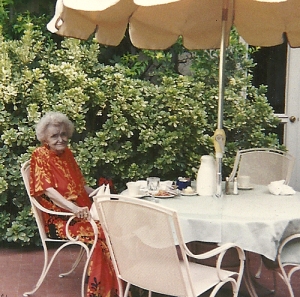Evangeline Walton (24 November 1907 – 11 March 1996) was the pen name of Evangeline Wilna Ensley, an American author of fantasy fiction. She remains popular in North America and Europe because of her “ability to humanize historical and mythological subjects with eloquence, humor and compassion”. (Spencer, Paul. “Evangeline Walton: an interview.” Fantasy Review, March 1985.)
Life
Born in Indianapolis, Indiana to Marion Edmund Ensley and Wilna Eunice Ensley née Coyner, Walton was a born scholar and came from a lively, educated, Quaker family. Walton suffered chronic respiratory illnesses as a child, and was privately or self-taught at home. Her parents separated and divorced in 1924. Growing up and living with her mother and her grandmother and witnessing her parents’ marital difficulties roused a natural feminism in Walton which appears throughout her writings. As a child, Walton enjoyed the works of L. Frank Baum, James Stephens, Lord Dunsany and Algernon Blackwood, which she would later cite as influences on her fiction. Walton and her mother traveled often to New York City, Chicago and San Francisco for opera, especially for Richard Wagner’s Der Ring des Nibelungen; opera was a passion her entire life. In 1946 after the death of her grandmother, Walton and her mother moved to Tucson, Arizona. Wilna Ensley died in 1971 but not before she saw the dawn of public recognition for Walton and her works.

Most of Walton’s published and unpublished works were originally written in the 1920s through the early 1950s. She worked on her best known work, the Mabinogion tetralogy, during the late 1930s and early 1940s, and her Theseus trilogy during the late 1940s. Once success found her after 1970, she reworked many of her manuscripts for publication over the next twenty years. Walton said of her knack for writing fantasy: “My own method has always been to try to put flesh and blood on the bones of the original myth; I almost never contradict sources, I only add and interpret.” (Spencer. Ibid.) In 1991, she underwent surgery for a brain tumor that proved benign. However, her health continued to decline.
The dust jacket of the 1957 UK edition of Son of Darkness (The Cross and the Sword, US, 1956) reads: “Evangeline Walton was born in Indiana, USA, and comes from a family who have always fought for tolerance and freedom. Her [Ensley] grandfather was in the American Civil War and her [maternal] ancestors were members of the famous Underground Railway which helped slaves to reach Canada. In her early childhood she developed a passion for mediaeval history and witchcraft and, although Son of Darkness was actually written in the Arizona desert, the idea first came to her when as a child she read of the Norse King Harald Fairhair’s love for the Lapp witch.”
Treated as a child with silver nitrate tincture for frequent bronchitis and severe sinus infections, Walton, who had extremely fair skin, absorbed the pigment of the tincture causing her skin to turn gray and darken as she aged. When she became well known in the fantasy world in the 1970s, her blue-gray skin made her appearance exotic, much like a benevolent deity from Etruscan tomb frescos.

Walton corresponded with the Welsh novelist, essayist and poet John Cowper Powys for many years. Some of Walton’s papers from 1936-1984—including biographic material, manuscripts and the correspondence with Powys—are archived in Special Collections at the Library, University of Arizona in Tucson. She was first cousin to Clifford C. Furnas (1900–1969), author of The Next Hundred Years, Assistant Secretary of War in the Eisenhower administration, co-founder of NASA and chancellor of SUNY Buffalo; and to Clifton J. Furness (1898–1946), professor of music and author of The Genteel Female: An Anthology (1931). Furness premiered several piano works of Charles Ives and knew many other contemporary American composers and musicians well. Furness edited and introduced a facsimile edition of Leaves of Grass (1939) and Walt Whitman’s Workshop: A Collection of Unpublished Manuscripts (1928). A writer himself, Furness encouraged, inspired and mentored his young cousin Evangeline.

Walton herself wrote about her chosen pen name, “I use the name Walton professionally, partly because I originally hoped to build up different lines of work under different names, partly because Walton is an old family name and appears on the Declaration of Independence. Not that I can trace any blood connection between my Quaker Waltons and the Declaration signer. They came from Virginia, and were supposed to have had a [Native American] man somewhere up the family tree. He may be the reason why both records and tradition trail off into vagueness. But when I was a child, old folk remembered the Waltons as very tall, very dark people, too full of restless energy to fit quietly into their peaceful little Quaker community: a vivid, turbulent note in it.”
Writings

Walton is best known for her four novels retelling the Welsh Mabinogi. She published her first volume in 1936 under the publisher’s unfortunate title of The Virgin and the Swine. Although receiving warm praise from John Cowper Powys, the book sold poorly and none of the other novels in the series reached print at the time. Rediscovered by Ballantine’s Adult Fantasy series in 1970, it was reissued as The Island of the Mighty. The Children of Llyr followed in 1971, The Song of Rhiannon in 1972 and Prince of Annwn in 1974. All four novels were published in a single volume as The Mabinogion Tetralogy in 2002 by Overlook Press. The four novels are translated and available in several European languages and into Japanese.
Walton’s Witch House was written in the mid- to late-1930s and published in 1945 as the first volume in “The Library of Arkham House Novels of Fantasy and Terror”. Centipede Press is preparing a new edition of Witch House due out in December 2013. It is an occult horror story set in New England. In 1956, she published The Cross and the Sword, a novel set during the Danish conquest of England and the destruction of its Celtic culture.

In 1982, Walton published the first of her Theseus trilogy The Sword is Forged. Walton had completed the trilogy in the late 1940s but the publication by Mary Renault of her Theseus novels in 1958 and 1962 kept Walton from publishing her own. The remaining two novels in the trilogy are, as yet, unpublished.
Walton published several short stories. The best-known of these are “Above Ker-Is” (1980), “The Judgement of St. Yves” (1981) and “The Mistress of Kaer-Mor” (1980). “They That Have Wings”, a suspenseful tale set during World War II, was published posthumously and appears in the November/December 2011 issue of Fantasy & Science Fiction magazine. The Mammoth Book of Best Horror republished “They That Have Wings” in its 2012, volume 23 anthology.

Also in 2012, Nodens Books launched with the publication of ten short stories by Walton, entitled Above Ker-Is and Other Stories. (For ordering from Amazon or from Lulu.) The ten stories collected in this volume are Walton’s best, and seven were never published before. (See the home page’s blog post on this site for reviews of this collection of stories.)
She also wrote many works that remain unpublished, including poems, a verse play and the remaining two volumes of her Theseus trilogy. Walton’s literary agent Douglas A. Anderson and the heir to her literary works are presently working to publish many of these gems in the next few years. So keep an eye out for new publications of Walton’s writings new to her readers.
Awards
- Mythopoeic Fantasy Award for Adult Literature, Best Novel nominee, 1972: The Children of Llyr.
- Mythopoeic Fantasy Award for Adult Literature, Best Novel winner, 1973: The Song of Rhiannon.
- Mythopoeic Fantasy Award for Adult Literature, Best Novel nominee, 1975: Prince of Annwn.
- Locus Award, 1975: Prince of Annwn, 20th place.
- Fritz Leiber Fantasy Award, “Gray Mouser Award”, Science Fiction/Fantasy’s Fantasy Faire, 1979.
- World Fantasy Convention, Convention Award, 1985.
- Locus Award, 1984: The Sword is Forged, 26th place.
- World Fantasy Convention, World Fantasy Award for Life Achievement, 1989.